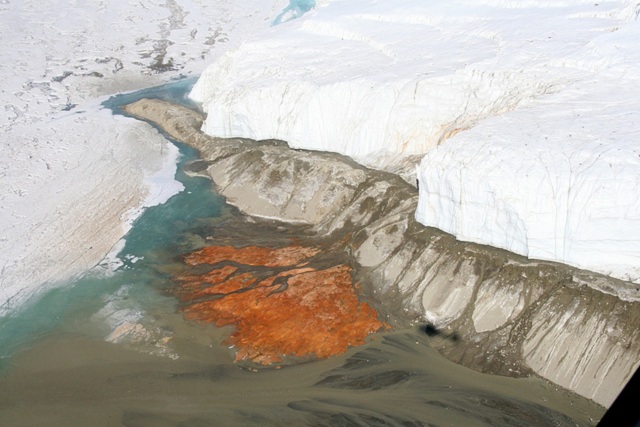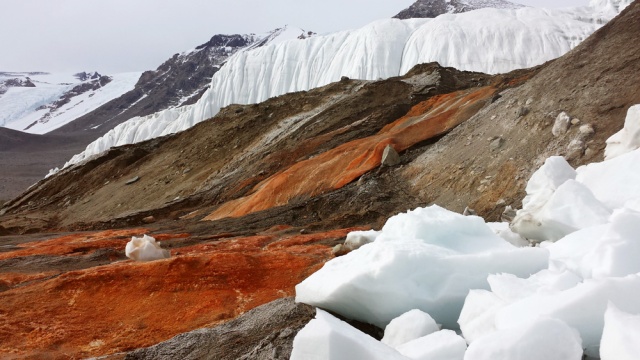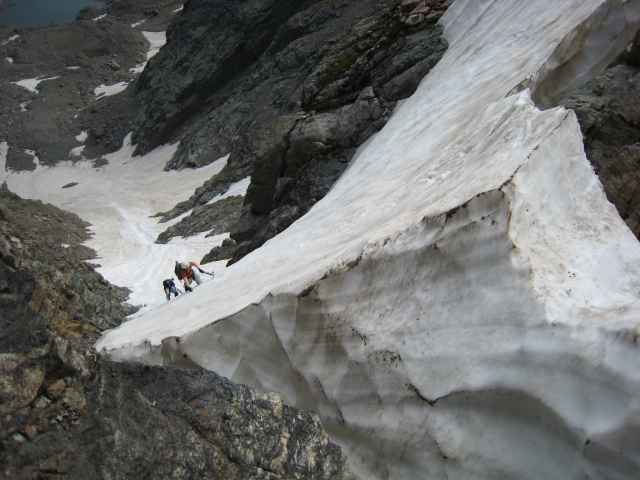This is an amazing sight ——— a 5-storey waterfall that gushes from a fissure, spills down the rocky shore into Antarctica’s LAKE BONNEY. This waterfall pours bright-red water right out of the white TAYLOR GLACIER. Its “shocking colour” and “gory appearance” are “alarming”, but, of course, this isn’t really blood. Its red colour comes from “iron”.
BLOOD FALLS is iron-rich, with hyper-saline water leaking out from a salt lake underneath the TAYLOR GLACIER. When the “iron” in the water comes into contact with the air, it oxidises and essentially rusts. This is what lends, the water, the “blood-red” colour that one sees when it spills down the glacier. The reddish discolouration, seeping out of Taylor Glacier, is due to iron oxides and some very old sea-water trapped during the MIOCENE PERIOD some 5 million years ago.
The Taylor Glacier is about 54km long, flowing from the plateau of Victoria Land into the western end of Taylor Valley, north of the KUKRI HILLS, south of the ASGARD RANGE. The middle of the glacier is bounded on the north by the INLAND FORTS and on the south by BEACON VALLEY.
The glacier was discovered by British National Antarctic Expedition (1901-1904) and, at that time thought to be a part of FERRAR GLACIER. The Western Journey Party of the British Antarctic Expedition (1910) determined that the “upper” and “lower” portions of what was known as FERRAR GLACIER are “apposed”, i.e. joined in Siamese-twin fashion north of KNOBHEAD. With this discovery, Scott named the “upper” portion for Griffith Taylor, geologist and leader of the Western Journey Party. —-The Taylor Glacier has been the focus of a measurement and modelling effort carried out by researchers from the University of California at Berkeley and the University of Texas at Austin.
Like the glaciers in the McMurdo Dry Valleys, this glacier is “cold-based”, meaning its bottom is frozen to the ground below. The rest of the world’s glaciers are “wet-based”, meaning they scrape over the bedrock picking up and leaving obvious piles of debris (moraines) along their edges. “Cold-based” glaciers flow more like putty, pushed forward by their own weight. “Cold-based” glaciers pick up minimal debris, cause little erosion and leave only small moraines. They also look different from above. Instead of having surfaces full of “crevasses”, “cold-based” glaciers are comparatively flat and smooth.
Perhaps at a time, when this valley resembled a “fjord”, some sea water was trapped in the lower portion of the valley. When the Taylor Glacier eventually advanced over the top of that lake, the sea water was essentially “freeze-dried” and “trapped”. The glacier moved forward and down through the valley, it captured some of the deposit and forced it up into the body of ice. The hyper-saline water fortuitously, through a “crack” in the ice, was “oxygen-free” and rich in sulphate and ferrous ion.





Amazing
Wow very nice!
Truly Amazing! Like mother earth is bleeding.
Truly…the wonders of nature are boundless! So much to see, so little time:)
Reblogged this on oshriradhekrishnabole.
This is amazing!